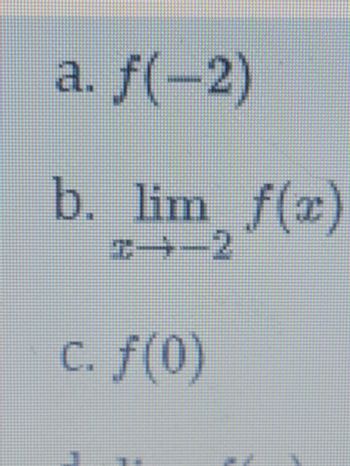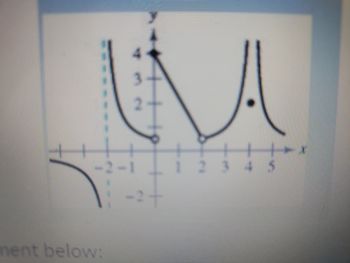
Calculus: Early Transcendentals
8th Edition
ISBN: 9781285741550
Author: James Stewart
Publisher: Cengage Learning
expand_more
expand_more
format_list_bulleted
Question
Hi! For this given question it has 8 subparts. I understand the rules of only 3. I am only asking for now for you to do A through C. Thank you.

Transcribed Image Text:Here is the transcription of the image content, which appears to be a list of mathematical notations related to the evaluation of a function and its limits:
---
### Mathematical Function Evaluation
**a.** \( f(-2) \)
**b.** \( \lim_{{x \to -2}} f(x) \)
**c.** \( f(0) \)
---
Each item represents a different mathematical concept:
- **Item a:** This is the evaluation of the function \( f \) at \( x = -2 \), giving the value of the function when the input is -2.
- **Item b:** This represents the limit of the function \( f(x) \) as \( x \) approaches -2. Calculating this involves determining the value that \( f(x) \) gets closer to as \( x \) approaches -2 from either direction.
- **Item c:** This is the evaluation of the function \( f \) at \( x = 0 \), giving the value of the function when the input is 0.
For further understanding, one may consult additional resources about function evaluation and limits in calculus.

Transcribed Image Text:**Graph Analysis**
The graph presented is a visual representation of a mathematical function plotted in a coordinate plane with the x-axis and y-axis as reference lines. Below is a detailed description and analysis:
1. **Axes and Grid Lines:**
- The x-axis is marked with tick marks ranging from -2 to 5.
- The y-axis is marked with tick marks ranging from -2 to 4.
2. **Function Behavior:**
- The function appears to be a piecewise function with different sections.
- There is a sharp, vertical asymptote at \(x = 0\). The function approaches negative infinity as it nears \(x = 0\) from the left side.
- From \(0 < x < 1\), the function is decreasing and then transitions into a curve that approaches a hole at \(x = 1, y \approx 2\). This signifies a possible discontinuity.
- At \(x = 2\), there is another hole in the function, indicating another potential point of discontinuity in the function.
- The function between 1 and 2 is downward sloping, reaching a local minimum before ascending to the discontinuity at \(x = 2\).
- From \(2 < x < 4\), the function rises steeply, reaching a peak around \(x = 4\) with \(y\) close to 4.
- There is a filled point at \((x = 4, y = 2)\), suggesting that the function value is explicitly defined at this coordinate.
- Beyond \(x = 4\), the function declines sharply.
3. **Key Points:**
- Asymptote at \(x = 0\).
- Holes or undefined points at \(x = 1\) and \(x = 2\).
- Filled point at \(x = 4, y = 2\).
This graph may be used to discuss various calculus and algebra concepts, such as limits, continuity, and types of discontinuities.
Expert Solution
This question has been solved!
Explore an expertly crafted, step-by-step solution for a thorough understanding of key concepts.
Step by stepSolved in 2 steps with 3 images

Knowledge Booster
Similar questions
- Follow the instructions given in the photo. Kindly provide a COMPLETE and CLEAR solution. Answer it ASAP because I really need it right now.The answer should be typewritten.arrow_forwardSimplify the following expression (Don't forgot attach your domain!) 2. -5x+4 2. x´ - 4x *You don’ t have to print this organizer for working but just follow it's direction & format.arrow_forwardChoose the answer that best describes the relationship between A={integers divisible by 2} and B= {integers divisible by 4} a. A C B b. B CA c. Both a and b. d. Neither a nor b.arrow_forward
arrow_back_ios
arrow_forward_ios
Recommended textbooks for you
 Calculus: Early TranscendentalsCalculusISBN:9781285741550Author:James StewartPublisher:Cengage Learning
Calculus: Early TranscendentalsCalculusISBN:9781285741550Author:James StewartPublisher:Cengage Learning Thomas' Calculus (14th Edition)CalculusISBN:9780134438986Author:Joel R. Hass, Christopher E. Heil, Maurice D. WeirPublisher:PEARSON
Thomas' Calculus (14th Edition)CalculusISBN:9780134438986Author:Joel R. Hass, Christopher E. Heil, Maurice D. WeirPublisher:PEARSON Calculus: Early Transcendentals (3rd Edition)CalculusISBN:9780134763644Author:William L. Briggs, Lyle Cochran, Bernard Gillett, Eric SchulzPublisher:PEARSON
Calculus: Early Transcendentals (3rd Edition)CalculusISBN:9780134763644Author:William L. Briggs, Lyle Cochran, Bernard Gillett, Eric SchulzPublisher:PEARSON Calculus: Early TranscendentalsCalculusISBN:9781319050740Author:Jon Rogawski, Colin Adams, Robert FranzosaPublisher:W. H. Freeman
Calculus: Early TranscendentalsCalculusISBN:9781319050740Author:Jon Rogawski, Colin Adams, Robert FranzosaPublisher:W. H. Freeman
 Calculus: Early Transcendental FunctionsCalculusISBN:9781337552516Author:Ron Larson, Bruce H. EdwardsPublisher:Cengage Learning
Calculus: Early Transcendental FunctionsCalculusISBN:9781337552516Author:Ron Larson, Bruce H. EdwardsPublisher:Cengage Learning

Calculus: Early Transcendentals
Calculus
ISBN:9781285741550
Author:James Stewart
Publisher:Cengage Learning

Thomas' Calculus (14th Edition)
Calculus
ISBN:9780134438986
Author:Joel R. Hass, Christopher E. Heil, Maurice D. Weir
Publisher:PEARSON

Calculus: Early Transcendentals (3rd Edition)
Calculus
ISBN:9780134763644
Author:William L. Briggs, Lyle Cochran, Bernard Gillett, Eric Schulz
Publisher:PEARSON

Calculus: Early Transcendentals
Calculus
ISBN:9781319050740
Author:Jon Rogawski, Colin Adams, Robert Franzosa
Publisher:W. H. Freeman


Calculus: Early Transcendental Functions
Calculus
ISBN:9781337552516
Author:Ron Larson, Bruce H. Edwards
Publisher:Cengage Learning